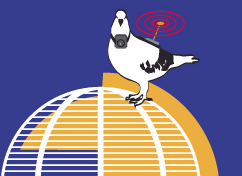|
|
|
|
Transvergence artworks
|
Feb 11, 2006 at 08:34 AM |
Concrescence + Game Machine + (^3)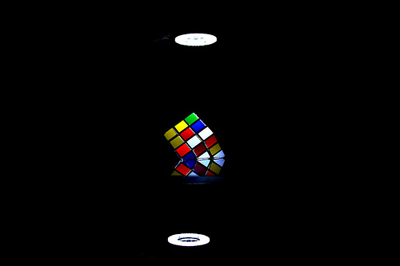
Through various experiments, installations, and online software, the abstractmachine project asks the question of how we as artists and users can create, manipulate, and ultimately enact digital algorithms. If the specificity of the computer comes not only from it's digital aspect, but even more so from it's algorithmic aspect, how does this hyperprogrammable nature transform the media we manipulate - i.e. the images and sounds we design using these machines? Amongst the many machines available within the abstractmachine project, two creation platforms will be presented to illustrate our response to these questions: one dedicated to the creation and manipulation of algorithmic cinema, the other designed around algorithmic musical composition. |
|
Last Updated ( Aug 04, 2006 at 09:12 PM )
|
|
Read more...
|
|
|
Feb 11, 2006 at 08:24 AM |
|
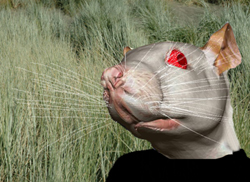 Exhibition at the Children's Discovery Museum of San Jose: Monday, August 7th - Friday, August 11th; 10:00 A.M. until 7:00 P.M.
(Please note that Children's Discovery Museum will NOT be participating in the ZeroOne San Jose 'Opening Night Crawl' event on Tuesday, August 8th, but will stay open that evening until 7:00 P.M.)
Saturday, August 12th; 10:00 A.M. until 10:00 P.M. (extended hours)
Sunday, August 13th; 12:00 P.M. until 7:00 P.M. From Tinguely’s auto-destructive art assemblages to Philip K Dick/Ridley Scott’s (Blade Runner) animal replicants, artists question what is ‘made’. Animals have a place in the history of performance, both tamed and trained, and in their role as placeholders of what it is to be ‘natural’. Donna Haraway positions our cyborg selves as creatures simultaneously animal and machine, who populate worlds ambiguously natural and crafted. It is in this pantheon of human, animal and machine that animalia positions us. |
|
Last Updated ( Aug 05, 2006 at 12:07 AM )
|
|
Read more...
|
|
|
Written by Administrator
|
|
Feb 07, 2006 at 05:49 AM |
|
Apocrypha
is a satirical work that posits a colony of prehistorical
archaebacteria as an “oracle” able to divine answers to questions
posed by “disciples” who contact the archaebacteria by web and on site
access. A receipt is issued upon completion of the transaction,
providing physical evidence of the deific exchange and a cryptic
prophecy for disciples to ponder.
The stimuli of text or voice message from
visitors to the exhibition via computer input elicits a chemical
response from a colony of archaebacteria. This response is translated
into text that the supplicant (or gallery visitor) is able to
interpret and apply to everyday life. The archaebacteria response is
actually a physical alteration that can be read as one of a series of
numbers. These numbers are mapped using code-breaking principles of
repetition and predicability onto corresponding lines of an ancient
text to create an apparently meaningful response to the problem posed.
The text utilised as the source of wisdom is the Apocrypha (an
ancient collection of sacred texts excluded from the canonised version
of the Bible). Originally, apocryphal writing was considered to be a
text of sacred origin, designated to be hidden until the due time of
its revelation.
|
|
Last Updated ( Jul 15, 2008 at 06:45 PM )
|
|
Read more...
|
|
|
assemblage for collective thought (act) |
|
Mar 15, 2006 at 12:25 PM |
|
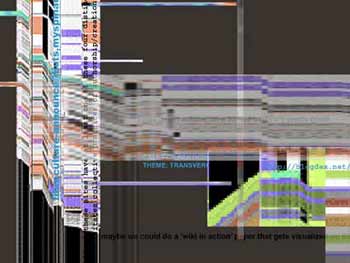
How do new thoughts form through distributed media? What are the collective dynamics through which these thoughts assemble? This presentation will use a combination of dynamic software from wikis through mapping to vj software to explore the processes through which new concepts emerge transvergently from collective practice. In assembling the texts and visualizations in this presentation, we do not wish to finish the process of collaborative thought production but rather shift it into another phase – to construct open machines that nurture collaborative authoring, technozoosemiotic processes, technozoomorphic forms and transvergent networks.
|
|
Last Updated ( Apr 19, 2006 at 11:55 AM )
|
|
Read more...
|
|
|
BIOTEKNICA LABORATORY REMIX |
|
Feb 11, 2006 at 08:57 AM |
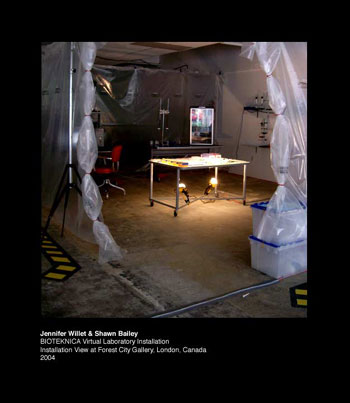 BIOTEKNICA: Laboratory Remix (with Teratological Prototypes in Collaboration with Tissue Culture & Art Project) is a complex installation, including functional laboratory equipment, a free standing tent, and a video work, all in support of a single tissue culture sculpture - a Teratological Prototype. Developed with Oron Catts and Ionat Zurr, the prototype consists of a P4HP bioabsorbable polymer scaffold sculpted in the form of a teratoma, and seeded with mammalian cells - growing live in the gallery environment. This work mobilizes the notion of remixing the laboratory environment as a critical turn in creating an interface between non-specialists - and ‘real’ and mediated representations of the laboratory. |
|
Last Updated ( Aug 06, 2006 at 09:14 PM )
|
|
Read more...
|
|
|
Feb 07, 2006 at 05:12 AM |
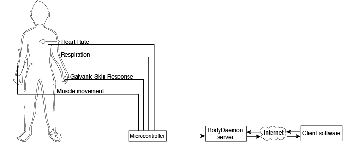 BodyDaemon is a bio-responsive Internet server. Readings taken from a participants physical states, as measured by custom biofeedback sensors, are used to power and configure a fully-functional Internet server. For example, more or fewer socket connections are made available based on heart rate, changes in galvanic skin response (GSR) can abruptly close sockets, and muscle movements (EMG) can send data to the client. Other feature's such as logging can be turned on or off depending on a combination of factors.
|
|
Last Updated ( Jun 01, 2006 at 10:04 PM )
|
|
Read more...
|
|
|
Feb 07, 2006 at 05:52 AM |
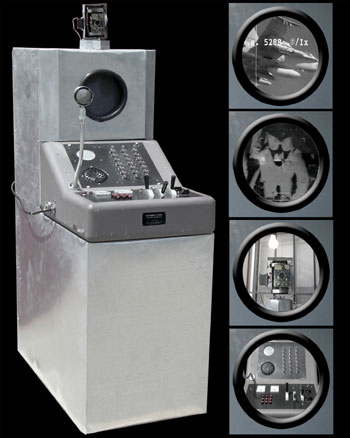
The DEFENDEX-ESPGX is an interactive art object that combines real-time audio and video synthesis processing with physical interaction. The DEFENDEX-ESPGX is designed to simulate the look and feel of 1950’s technology. The content draws on nostalgic reference to bring about implied comparisons between the fearful culture of the Cold War and the culture of fear associated with the current War on Terror. |
|
Last Updated ( Apr 12, 2006 at 01:41 PM )
|
|
Read more...
|
|
|
Written by Administrator
|
|
Feb 07, 2006 at 05:29 AM |
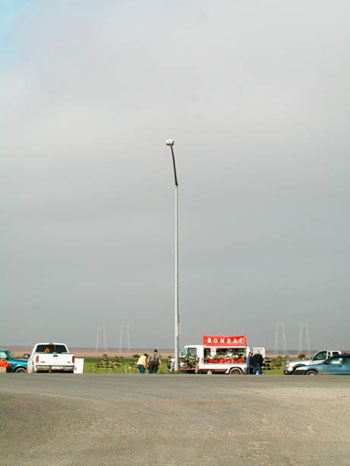
I-5_Passing Project, ©Robbins, Jetztzeit Studios, 2001-08.
We live in the beginning of a “new” century in which the public
sphere in California has shrunk, been compressed, and themed to the
point of annihilation of any fixed point of authenticity. The current
institutionalized regional development of the I-5 Freeway - the
connective tissue between Los Angeles and San Francisco - is narrowing
the bandwidth of cultural programming, social interaction and
environmental concerns to that of lifestyle, market dynamics and
branding. The next paradigm of social space, just now emerging, is a
broadened spectrum ranging from the banal to the ecstatic – from
contested visions of suburban utopia to suburban dystopia.
We find ourselves now living in a “flat-space” where 20th century
notions of living have taken on wholly different and contested
meanings. Whereas “flat space” once evinced a topographical description
of the central valley, it now references an intensified agglomeration
of big box stores, highway infrastructure and parking lots in which
space is corporate, Tyvek wrapped and hyperefficient.
|
|
Last Updated ( Jul 15, 2008 at 05:12 PM )
|
|
Read more...
|
|
|
Written by Administrator
|
|
Feb 11, 2006 at 08:45 AM |
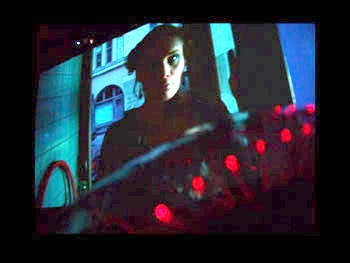 Obsession is an attempt to describe, how the traumatic acts of violence not only affect the individual, but how her family and life-environment are also violated. The narrative level of Obsession discusses subject matter of "sex and violence" in our representational culture. Inside the four walls of a self-service launderette, young Emmi and an entrant stranger, Henrik, measure embodied distance. From their interaction, a loaded emotional situation emerges. The computational core of Obsession is a narrative engine, based on content metadata. Inspired by the Russian film theorist Sergei Eisenstein, the”montage-machine” of Obsession maps spectators’ psycho-physiological states to cinematic elements. |
|
Last Updated ( Oct 04, 2006 at 07:56 AM )
|
|
Read more...
|
|
|
Particles of Interest: Tales from the Matter Markets |
|
Feb 11, 2006 at 08:03 AM |
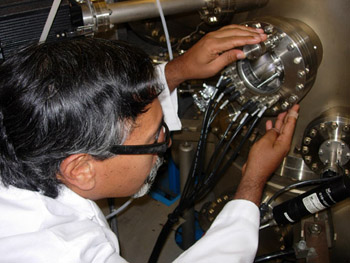
"Nanofabric is the new black in fashion apparel and accessories."- Hugo Boss, 2005
"Patenting particles makes everyone smile around here."- Harris & Harris Group (Nasdaq:TINY), Sep. 21, 2005 Particles of Interest: Tales from the Matter Markets will be a 3 stage event project for ISEA 2006: stage one, an on-line Open Particle Patenting System; stage two, a Particle Tale installation to be constructed in San Jose, California; stage three, Trans_patent campaign in collaboration with invited artist, artists groups, scientist, activist and stock traders around the planet.
|
|
Last Updated ( Aug 07, 2006 at 01:06 PM )
|
|
Read more...
|
|
|
Feb 11, 2006 at 08:38 AM |
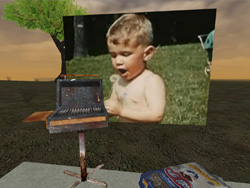 Playas, New Mexico has always been a virtual construct. With past lives as a railroad town, mining town and ghost town, it is now slated to be used as an anti-terrorist training facility for the Department of Homeland Security. This installation uses the metaphor of the mirage to investigate the "reality" of our constructed meanings. The game player explores the remnants of this shell and discovers tracings of previous lives, all the while, avoiding those who might present harm. Viewers of the installation are unable to avoid contribution to the scenario as they instigate the spawning of in-game characters, some innocent, and some malevolent. Similarly, as they move through the environment their presence has repercussions, perturbing the vision like a mirage. In the end, there are no winners, but hopefully there exists a set of questions about our place in the world, our constructions, and our personal responsibility for the end result.
|
|
Last Updated ( May 04, 2006 at 10:58 AM )
|
|
Read more...
|
|
|
Feb 07, 2006 at 05:40 AM |
|

RPM's Remixed is a telematic, transdisciplinary performance based on remixing Alvin Lucier's "RPM's" score – integrating dance, video and sound improvisation between artists in New York, Houston, Tampa, and Los Angeles.
Alvin Lucier, a well-known composer of music and sound installations that explore natural phenomena and resonance, is renowned for making spaces "sing." This piece explores the possibilities of using one of his scores to make a virtual space "sing" by using improvisational techniques as well as the natural feedback and delay created by streaming. |
|
Last Updated ( Apr 12, 2006 at 01:47 PM )
|
|
Read more...
|
|
|
TRANSCODED NATURE - The Origin of Order |
|
Feb 11, 2006 at 08:53 AM |
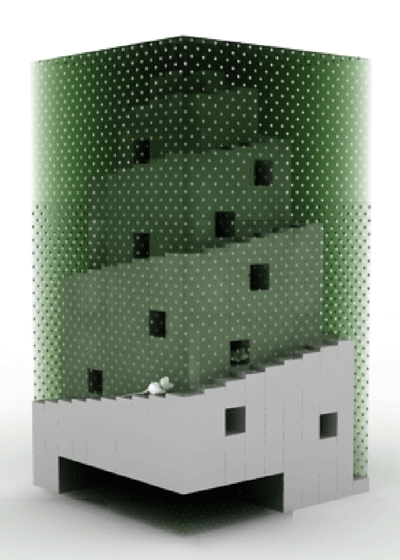 Emerging Forms Research Group – RASTER Vladimir Todorovic, Goran Andrejin, Damien Lock TRANSCODED NATURE _THE ORIGIN OF ORDER is the first in series of projects, which observe movements and changes of transcodabilities in nature. Transcoding is not observed as a change in a code or a format, but as a change of the whole through the order of the transformed code. While trying to address and frame those data metamorphoses, this project results in intentionally formal outcomes. Manifestations and forms are aiming for monumentality, formalism, and unquestionable transcodability. The effect often includes conceptualized and contextualized reactions to the previous data mutations. The first project in this series analyzes the origin of the order by transcoding the signals from a semi-eco system, or an eco simulation, in which rodents live and play. In this environment, some data from the physical space are shared with the data from a computer game and then transcoded into sound output. |
|
Last Updated ( Jul 19, 2006 at 10:25 AM )
|
|
Read more...
|
|
|
|
| |
|
|
|
